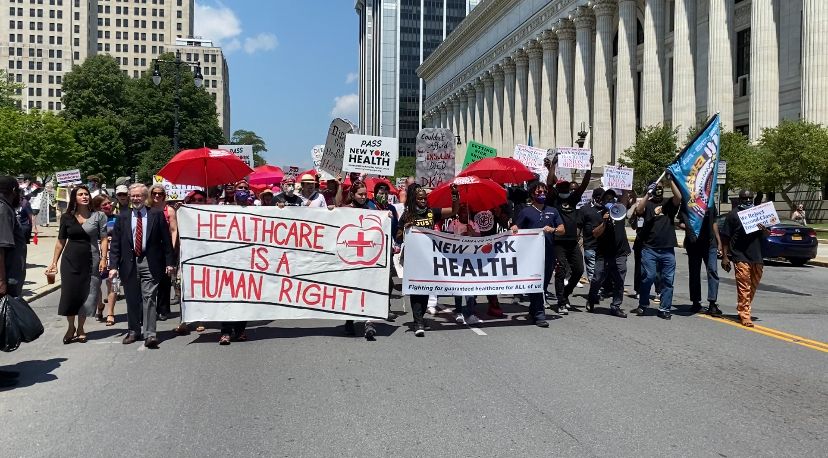Social Determinants of Health and the New York Health Act

By Helen Krim
Social Determinants of Health encompasses all the non-medical factors that influence our health and wellness. Our genes are a relatively minor factor accounting for only 30% of our health outcomes. Seventy percent of our outcomes result from economic conditions, our neighborhood and physical environment, food, education, economic stability, community and social contexts, and our healthcare environment. Each of these factors, in turn, interacts with other factors that together impact our health
For example, the impact of food on our health depends on the availability of healthy food, and enough economic stability to prevent food insecurity. Lack of access to healthy food and food insecurity both lead to unhealthy eating habits, which can result in diabetes. During the pandemic we saw how neighborhood conditions such as unemployment, densely populated housing, and the absence of parks for outdoor recreation greatly contributed to the spread of disease and death. Community context has a tremendous negative impact on immigrant populations, particularly on the undocumented, where discrimination and stress can disrupt families and supportive social networks. The interaction of these social determinants of health together contribute either to the well-being or to the distress of a community.
The healthcare environment comprises healthcare coverage, availability of providers, pharmacies, language and culturally appropriate care, and quality care. Statistically, of the 62 counties in New York State, health outcomes in the Bronx are the worst. During the last 9 years, according to the Robert Wood Johnson Foundation and the University of Wisconsin Population Health Institute, 31 to 45 % of the population in the Bronx lived in poverty. Diabetes deaths per 100,000 ranged from 33 to 65, the highest in the state. Asthma hospitalizations per 100,000 ranged from 865 to 1637. Hospitalizations for drug use per 100,000 were the highest in the state and ranged from 605 to 1329. These dismal outcomes are the result of the negative impact of social determinants of health in the Bronx, and the lack of access to regular preventive medical care.
Few people are truly satisfied with the health insurance industry in the United States today. In New York State, 5% of our population cannot afford any insurance. Fifty percent have insurance, but cannot afford to use it because of co-pays, and deductibles. They put off care. A third of those people report developing serious and costly conditions. Approximately 60% of people in bankruptcy court are there because of medical debt. It does not have to be this way.
The New York Health Act would cover every resident of New York State regardless of immigration or employment status. The bill provides preventive care, reproductive care, mental health care, addiction services, dental, vision and hearing care, prescriptions, and long term care. Copays, deductibles, and out of network charges would be eliminated, so people would be able to access care when they need it, and before they become seriously and expensively ill.
The bill would be paid for in part from savings resulting from the elimination of the 55 billion dollars in profit earned by insurance companies in NYS, savings resulting from the power of the state to negotiate drug prices for 23 million New Yorkers, and savings resulting from eliminating the administrative bureaucracy needed to manage the billing for the approximately 55 insurance companies operating in New York. Another major portion of the funds for the New York Health Act would come from a progressive income tax. Estimates vary slightly, but two comprehensive economic analyses of the New York Health Act (the 1915 Friedman study at the University of Massachusetts at Amherst and the 1919 study by the Rand Corporation) determined that 95 % of New Yorkers would pay less than they are paying now for healthcare, when deductibles, copays and out of network charges are eliminated.
Because of the size and complexity of the Act, the New York Health Act establishes a Board of Trustees with representatives of all stakeholders to work on the details and timing of implementation. The Board has two years to develop proposals for every aspect of the plan from finance to integration with existing federal and state programs and institutions. Implementation may take another two years. We know the bill is being considered seriously, because the leadership has established working groups to study the plan, and because of the dramatic increase in advertisements for insurance companies and pharmaceuticals. The bill has no budget implications at this time, but must pass this year, because of the long time needed for implementation. Answers to the most frequently asked questions can be found at nyhcampaign.org. It is important that every New Yorker learn about the New York Health Act and advocate for its passage.
Helen Krim
Helen.krim@gmail.com
